#so here we have our damsel in distress… given growth and a beginning by a man that only wants to really trap her again
Explore tagged Tumblr posts
Text
“A love story with a psychological interest … a rather doubtful experiment with a public who expects a certain style from an author."
— Lucy Maud Montgomery, the Selected Journals of, on the subject of 'Kilmeny of the Orchard'
#the kilmeny read-along has been sooo funny to third-party#you guys are so genius#i always felt like kilmeny was maud’s ‘gotcha’#mostly because of this above journal entry#it felt like a total satirical play on traditional fairy tales#right down to how we see kilmeny’s life truly begin and develop and the moment she meets her ‘prince’ eric#like#right after she meets eric things progress for her… she sees herself for the first time… she perceives herself… and in the end she speaks#all things she hadn’t or couldn’t achieve without him#so here we have our damsel in distress… given growth and a beginning by a man that only wants to really trap her again#say nothing of the way kilmeny is the titular character and yet it is ERICS story#this feels like maud (a huge lover of fairy tales in general) having a bit of a go at these old-timey stories#how easy it is to suppose she was poking some fun at the Way of the World then too#her own existence as a woman was about to transform at the time she wrote it… she was engaged to ewen in 1908#ANYWAY that is my whole entire 2¢#i’m about to go like posts and make it EVERYONEs problem so RIP to y’all’s notifs#lucy maud montgomery#kilmeny of the orchard
29 notes
·
View notes
Text
Jaune: Zero to Hero
Pyrrha: It's not about why; it's about knowing. Understanding dark and light helps us manifest our Aura. Everyone has some of both.
Knowledge, Creation and Destruction all lead up to Aura. This is just another way to say that they lead up to individuality, which is something Grimms lack:
Pyrrha: They are creatures of Grimm, the manifestation of anonymity.
Individuality is conveyed through Choice. This is why Choice is the most important and final gift. It is symbolic of self-actualization, which is what our characters are pursuing in their coming of age story.
Jaune’s personal arc comments the group’s collective journey and marks each stage very clearly.
In which way does it happen? And what do these stages mean for Jaune’s growth as an individual?
THE IGNORANT WARRIOR
Pyrrha: Jaune, do you... know what Aura is?
Jaune: Psch! Of course I do! Do you know what Aura is?
Jaune is introduced as inexperienced and ignorant. He lacks combat experience and knows nothing about key concepts like Aura, Landing Strategy or Semblances.
His journey starts because Pyrrha shares her knowledge with him:
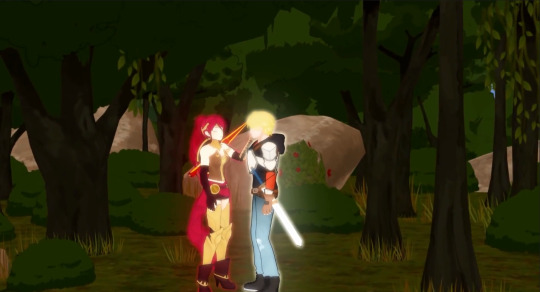
She awakens his aura, his very soul and later on trains him, so she helps his body get stronger:
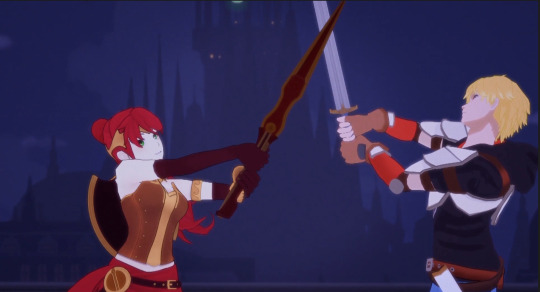
In other words, Pyrrha is the one who puts Jaune on the right path to become a true “hero” and a “warrior”.
This is Jaune’s objective since the beginning, but he initially pursues it in the wrong way:
Jaune: I don't want help! I don't want to be the damsel in distress! I want to be the hero!
He is fixated on an idea of hero which is outdated and has its root in toxic masculinity:
Jaune: Cause this is always what I've wanted to be! My father, my grandfather, and his father before him were all warriors! They were all heroes! I wanted to be one, too. I was just never good enough.
This is why symbolically Jaune wants to be like his male ancestors. He wants to grow into “a real man”:
Cardin: Let's see how much of a man you really are...
And this is conveyed also through his Weapon:
Jaune: It's a hand-me-down. My great-great-grandfather used it to fight in the war.
Jaune did not forge his own Weapon, but he inherited it. Crocea Mors initially represents the legacy he wants to live up to. However, this legacy, instead of driving him, slows him down because he can’t grow until he remains in his ancestors’ shadow. Jaune needs to develop his own individuality instead.
In order to do so, he needs to grow not only as a figther, but as a person too.
As a matter of fact, Jaune’s ignorance is not only limited to the world he has stepped into, but also to the people around him:
Jaune: That's easy for you to say. You've probably got guys clamoring over each other just to ask you out.
Pyrrha: You'd be surprised.
He is so self-focused that he does not notice others’ feelings and hurts them unintentionally.
However, Pyrrha teaches him once again:
Pyrrha:Tell her exactly what you said. No ridiculous schemes, no pick-up lines. Just... be honest.
It is thanks to her that Jaune manages to become a better man:
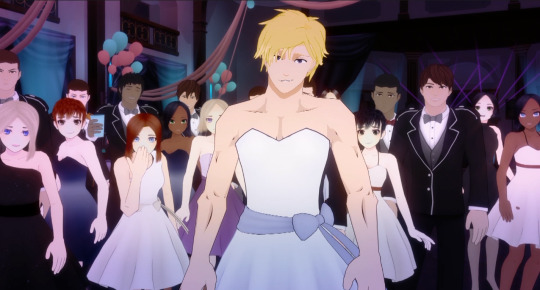
He is even able to call Neptune out the way Pyrrha did with him:
Jaune: Then just go talk to her. No pickup lines, no suave moves, just be yourself. I've heard that's the way to go.
And as a result, even Jaune’s relationship with Weiss gets better:
Weiss: You said you were embarrassed at first. What made you come talk to me?
Neptune: You're looking at him. You got some good friends looking out for ya.
Because the girl realizes Jaune is not only after her money or her romantic attention:
Weiss: All my life, boys have only cared about the perks of my last name.
But wants to genuinely be a good friend to her.
In short, Jaune starts the story as immature both as a fighter and as a person to the point that he is considered unfit and annoying by other characters:
Glynda: I don't care what his transcripts say. That Jaune fellow is not ready for this level of combat.
However, thanks to Pyrrha, he is given the chance to mature.
Not only that, but while other characters see a weakness and a nuisance in Jaune’s ignorance and inexperience, Pyrrha sees it as a possibility:
Weiss: Jaune, is it? Do you have any idea who you're talking to?
Jaune: Not in the slightest, snow angel.
Weiss: This is Pyrrha.
It is specifically because Jaune is new to Pyrrha’s world that he is free from bias:
Pyrrha: That's what I like about you. When we met, you didn't even know my name. You treated me just like anyone else. And thanks to you, I've made friendships that will last a lifetime. I guess, you're the kind of guy I wish I was here with. Someone who just saw me for me.
This is why Pyrrha feels she can forge a genuine bond with Jaune. What is more, the girl has faith in his potential:
Pyrrha: It's all right. I used my Aura to unlock yours, but the energy that protects you now is your own. You have a lot of it.
She sees in him what others do not and helps him develop both as a man and as a warrior.
This is well highlighted by the metal motif the two characters share.
As @hamliet explains here Rwby has several characters linked to the seven metals of alchemy.
The goal of alchemy is to create gold thanks to a process of refiniment that purifies the metal and has it go through several transformations.
The seven metals are nothing, but a scale that goes from the heaviest and most raw metal (lead) to the most purified (gold) passing through the others (tin, iron, copper, mercury, silver).
For a story, it simply means that a character goes through a process of change that leads to self-actualization.
In Rwby this idea is conveyed through specific characters embodying a metal (Ironwood, Penny, Mercury) or even thanks to metal motifs commenting a specific part of a character arc.
For example, Yang is associated with gold:
I am the golden one Who burns just like the sun
But Adam takes her arm away and has her regress in the scale of metals to iron. This regression is not simply physical, but psychological as well:
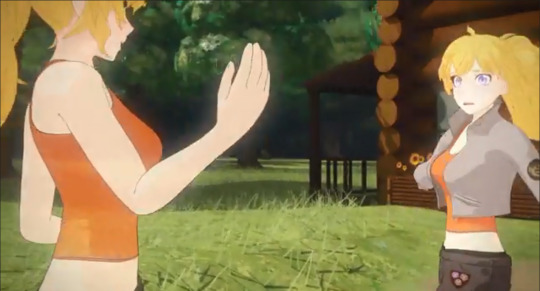
However, Yang re-affirms herself and moves forward. The first step of this process is to symbolically make her new arm “gold” again:
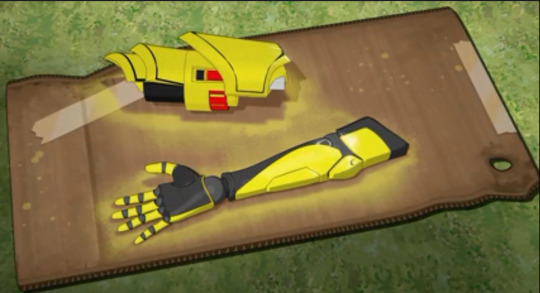
When it comes to Jaune, I think that he may be the character associated with lead aka the “prima materia” that needs to be molded into gold. Even if this is not true, metal is at least definately still a motif in his arc, as it is in Pyrrha’s. This is why both characters wear metal armors, differently from others.
Pyrrha is already close to her self-actualization and she reaches it in the climax of the Vale arc, where she completes her (tragic) arc and dies a Maiden.
This is why her armor is gold, while Jaune’s is white and gray. Pyrrha is at the top of the metal scale and close to the end of her journey, while Jaune is respectively at the very bottom and at the very beginning.
He is the embodyment of the prima materia that has potential for greatness, but only if he is rightly guided and if he himself works hard.
Pyrrha takes over herself the duty to help Jaune mold himself.
This is underlined also by Pyrrha’s semblance:
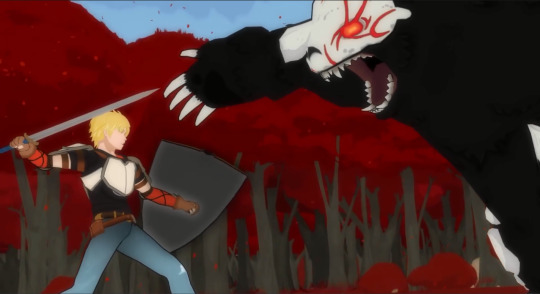
Pyrrha: Well, Ruby has her speed, you have your glyphs. My Semblance is polarity.
Pyrrha can control and bend metals and she shows her power for the first time when she helps Jaune against the Ursa, so that he can overcome his self-issues.
So, Jaune starts the story as the lead and is going through a path of self-refinement which will lead him to become gold, so more similar to Pyrrha herself.
Pyrrha offers him the basic knowledge to start this journey, but unluckily leaves him too soon and now Jaune has to move forward on his own.
THE CREATIVE AVENGER

Pyrrha: I want you to know that I'm just happy to be a part of your life. I'll always be here for you, Jaune.
Even after Pyrrha’s death, this stays true:
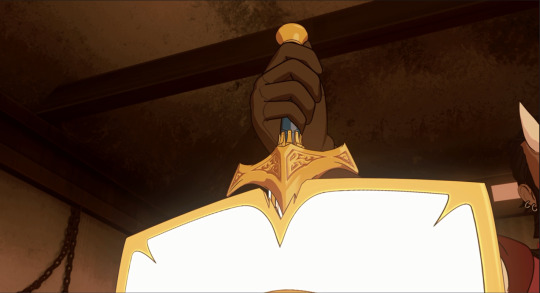
Blacksmith: That was some fine metal you brought me. Accents the white nicely. Where'd you get it from?
Pyrrha has become a part of Jaune.
This is a recurring motif in Rwby:
Penny: I won’t be gone, I’ll be part of you.
It is the idea that grieving is a process that leads to acceptance, but also to integration with a lost one. It is a way to have the deceased keep on living through the survivors.
In Jaune and Pyrrha’s case, this is conveyed through Pyrrha’s metal being used to enrich Jaune’s Weapon.
As stated by Ruby:
Ruby: Just weapons? They're an extension of ourselves! They're a part of us! Oh, they're so cool.
Weapons are symbolic of the self, just like Semblances.
What is more, Weapons and Semblances are also a declination of the dychotomy of body and soul, presented by the series.
Weapons are wielded by bodies, while Semblances are a materialization of the soul.
In other words, Pyrrha’s gold becoming a part of Jaune’s Weapon is symbolic of Jaune’s first step in a painful process that will lead him to overcome his partner’s death and to inherit Pyrrha’s legacy.
Jaune must keep on learning from Pyrrha and become more like her. As noted by @hamliet, this is symbolized also by Jaune’s design aquiring more golden details as he goes on in his journey:
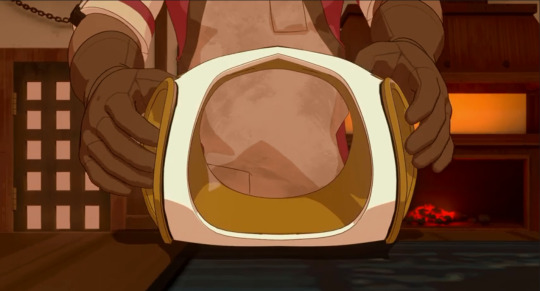
Jaune: Guess I was going to grow out of it eventually.
Ren: A sign of progress.
Jaune: Progress.
That said, grieving is not easy and Jaune must struggle with much pain and negative feelings.
This is why the changes he makes to Crocea Mors are finalized to increase its attack power:
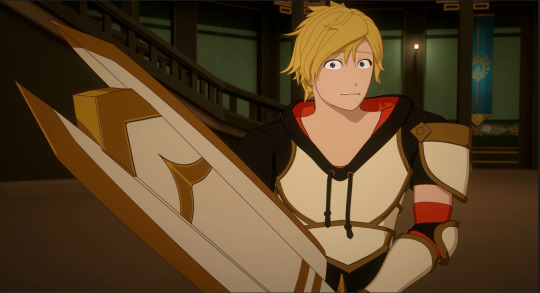
It is because Jaune feels anger over Pyrrha’s death and wants revenge.
In the Battle of Haven he gives in to his fury and tries to kill Cinder. He is trying to superficially imitate Pyrrha’s sacrifice:
Jaune: If I die buying them time, then it's worth it. They're the ones that matter.
However, he is not doing it out of bravery or necessity, but out of recklessness and self-hate. This is why his actions lead to this:
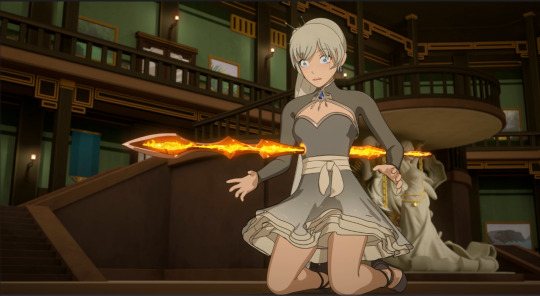
Once again, Jaune risks to lose another loved one:
Jaune: No, no, no, no, not again! Weiss, c'mon, please!!
However, this time he is able to save Weiss thanks to his Semblance:
Jaune: My Semblance?
Nora: How else do you think you're healing her, dummy?
Jaune gives up on using his Weapon to fight and chooses to use his Semblance to cure. He chooses soul over body and Creation over Destruction.
At the same time, Jaune’s activation of his Semblance is meaningful on two levels:
Jaune: No. I don't think I'm healing her. Our Aura heals our bodies. It feels... it feels more like I'm using my Aura to amplify hers!
Nora: Wait, aren't you worried about running out?
Jaune: Pyrrha once told me I've got a lot of it. I still believe her.
First of all, Jaune’s Semblance is rooted in the idea that people heal themselves. His power is not to cure others, but to amplify others’ auras, so that they can become stronger and can heal. It is about bringing out the best in others. It is a power fit for a leader, but also an ability symbolic of Jaune’s own process of healing. He can heal himself through helping others to heal.
Secondly, Jaune’s Semblance is in itself a nod to Pyrrha. Pyrrha used her own aura to awake his and Aura Amp is simply an evolution of this idea. It is not about activating others’ auras, but it is a power that lets Jaune share his. It also makes good use of something Pyrrha noticed immediately aka Jaune’s huge quantity of aura.
In other words, Jaune ends up acting like Pyrrha in the Battle of Haven, but not because he fights Cinder, but because he shares his gift with others, just like Pyrrha did with hers.
Pyrrha is a part of Jaune both in body (Crocea Mors) and soul (Aura Amp), but Jaune must still truly understand what this means.
He makes progress in Lost:
Red-Haired Woman: She understood that she had a responsibility... to try. I don't think she would regret her choice, because a Huntress would understand that there really wasn't a choice to make. And a Huntress is what she always wanted to be.
This is the essence of Pyrrha’s sacrifice. Jaune comes to understand it and chooses to make a similar choice together with his team:
Jaune: I think... I think she knew she wasn't going to win. That she might not come out alive. But... she also knew she was the only one that could try.
Ren: So she did.
Nora: Maybe we should too.
Jaune: Yeah, we should.
In this way, it will be as if Pyrrha were fighting together with them:
Nora: Pyrrha may not be by our side anymore, but we can fight like she is.
Jaune: And in a way... she will be.
Jaune tries to overcome his anger and his sadness for Pyrrha’s death in order to keep fighting like she did.
So, once again he chooses this:
Ruby: I wanted to protect my friends.
Maria: Precisely! It is the desire to preserve life which fuels the light inside you. And to make no mistake, it is light. Preservation is an extension of creation, or, at the very least, an enemy of destruction. The Creatures of Grimm were made by the God of Darkness, but your light comes from his brother.
He chooses to protect life and this is the essence of Creation.
Once he confirms this choice, he is free to explore Creation’s potential and he does so in the land of Creation itself, Atlas.
He strengthens his shield instead of his sword:
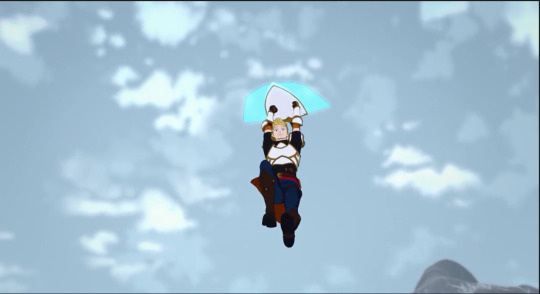
And he trains his Semblance:
Oscar: Nice, your recovery is getting faster.
This all leads him to become stronger psychologically:
Ren: Him on the other hand... There's no fear at all. I can see it, he believes we're going to get this done.
That said, Jaune starts meeting limits to his new found strength rooted in Creation:
Jaune: Ah, sorry. No matter how much I boost you, they won’t go away.
Jaune: Did... I stop the virus?
Penny: No. It’s still there.
Jaune’s way to move forward is to heal himself through healing others. Still, what to do when this is not possible?
THE DESTRUCTIVE HEALER
Penny: No… there’s not enough time to heal me…
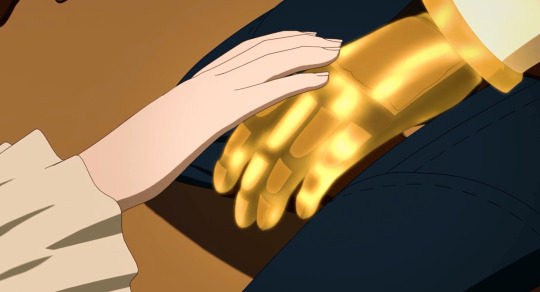
Penny: But there is something you can do…
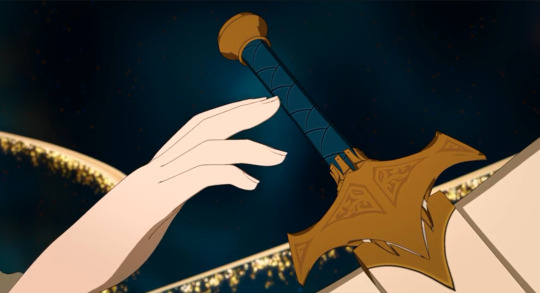
What happens in Atlas is an inversion of Haven.
Penny pushes Jaune’s Semblance away and touches Crocea Mors.
Jaune is asked to give up on healing her and to speed up her death instead. He is asked to choose his Weapon (body) over his Semblance (soul) and Destruction over Creation.
This marks the characters entering the Destruction phase:
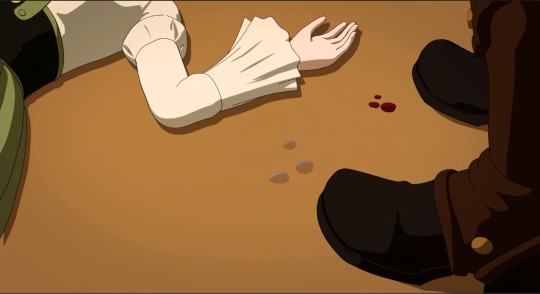
Leaving Creation (Penny) behind.
For Jaune, this means that his own self image that he has worked so much to build and to make his own:

And that has been enriched in Anima thanks to Pyrrha...is shattered:

At the same time, he is once again put in a similar spot as Pyrrha:
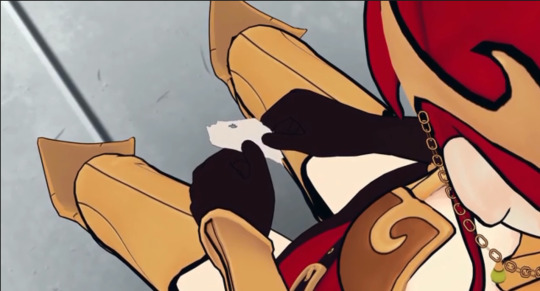
They both become unwilling agents of Penny’s death because of Cinder (and Emerald and Mercury in the first case):
Pyrrha: Ruby, I... I'm so sorry.
Ruby: Me too. But it wasn't your fault.
Jaune: She's right. Whoever was on that microphone... they're the ones that did this. And we have to make sure they don't take anyone else.
So Jaune’s journey to integrate with Pyrrha, to understand her and her struggle continues.
What now?
It is too soon to say because we have yet to properly start our journey through Destruction and what it is about.
That said, there are two things that are worth highlighting. The first is a motif Rwby is following, while the second is a general theme found in many stories.
1) As @hamliet has stated in many metas and as I have written here, Rwby is an alchemical story. Alchemical stories are usually marked by three important deaths. Each death is symbolically linked to a color. They are usually black, white and red. However, sometimes there can be yellow instead of the white or the red. This is the case here, where a resonant death is the yellow death aka Penny’s.
It is a death that happens while the characters are surrounded by yellow:
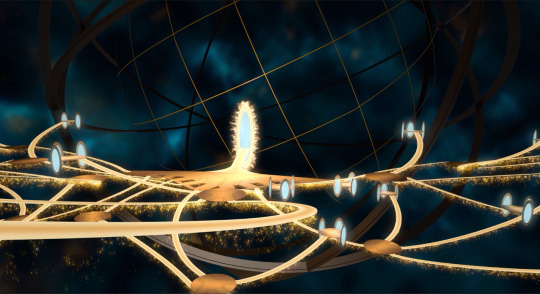
And it happens through a weapon called “Yellow Death” (Crocea Mors’s meaning). So, it is really not subtle. Penny’s death is meant to mark an important passage for our protagonists, just like Pyrrha’s one (the black death).
2) It is common in stories that deal with healers to explore the concept of death as well.
The basic idea is that a healer is a person meant to cure. That said, they will meet people impossible to cure and that will die on their watch. This is an unescapable truth a true healer must live with.
Let’s highlight this theme is found in works very different for genre and culture.
Let’s have two examples.
Scrubs aka an American comedy about doctors deals with this theme multiple times. In many episodes the characters must simply accept they can’t save a life, but must still not lose hope and keep on living themselves.
Yosano from the manga BSD says so:

Her backstory explores the link bewteen life and death further since it is shown that a power that cures fatal wounds can be used to cheapen life itself:
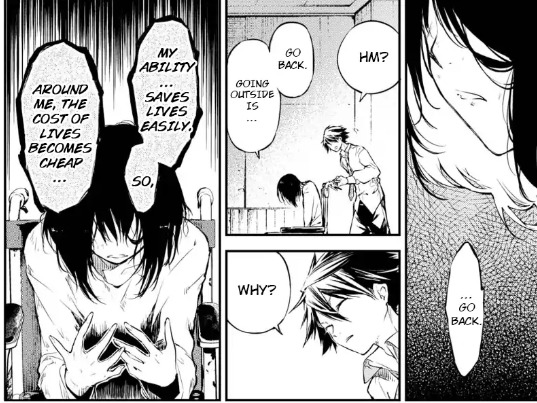
It is too soon to say if Rwby will explore a similar theme, but the fact that Jaune, (the healer) is the one that has to speed up Penny’s death might be a very powerful and poignant choice. This is true especially because Rwby does not refuse Destruction (and so does not refuse death), but presents it as a principle equal to Creation (so as a part of life).
THE CHOOSING HERO
Jaune’s arc is about living Pyrrha’s death over and over again with different scenarios and outcomes. This happens so that in the end he can finally overcome it.
So far, it has happened three times and each time has been in the climax of an important battle.
The Battle of Beacon has him witness powerlessly to Pyrrha’s death (lack of knowledge and passivity).
The Battle of Haven has him saving Weiss (creation).
The Battle of Atlas has him killing Penny (destruction).
What is more, every time Jaune becomes more proactive and conscious of what he is doing.
In Beacon he has no idea of what is happening. He works with little information and things happen to him without him being able to do anything.
In Haven his actions lead to Weiss being in danger, but he manages to save her. That said, he does not do it consciously. He unlocks his Semblance because of emotional stress. It is an unconscious choice and not a conscious one.
In Atlas he makes a specific conscious choice, but it is a choice that is forced on him because of external circumstances. It is also a choice that is meant to challenge and temporally break him.
In other words, he is slowly and painfully approaching Choice aka self-actualization. Right now, he has to face the consequences of Penny’s death, but this will probably lead him to finally enter the Choice stage and to complete his arc by becoming a “hero” aka gold (probably).
At the same time, this final choice will also be about healing and overcoming grief. It will be the final integration with Pyrrha and him being able to honor her legacy.
After all, we have been told from the beginning what Pyrrha’s fate would have been. We’ve just failed to notice:
Pyrrha: For it is in passing that we achieve immortality. Through this, we become a paragon of virtue and glory to rise above all, infinite in distance and unbound by death. I release your soul, and by my shoulder protect thee.
June and Pyrrha’s bond is eternal and she is meant to be the key character in Jaune’s arc. It is only through confronting and finally overcoming her loss that Jaune can finally self actualize and become the person Pyrrha has always known he could be. Pyrrha will symbolically be with him in this struggle. Her memory will protect and inspire him.
163 notes
·
View notes
Link
Guillermo Del Toro is no stranger to widespread acclaim, especially from his ride or die legion of fans. Pan’s Labyrinth, the Hellboy duology, the list of genre-bending, timeless masterworks goes on. Coming off his 2 Oscar wins for The Shape of Water in 2018, and moving into finally releasing his animated Pinocchio film from the pits of development hell along with an adaption of Nightmare Alley next year, this couldn’t be a more thriving time for the Mexican auteur. Though amongst all the praise and glory, something has still felt missing these last handful of years. Besides his Oscar-winning film, Del Toro’s works prior to the 2010s are what generally buzz conversations of his genius. Those aforementioned films did, after all, skyrocket his name to fame. His titles from the last decade, however, are just as crucial to the Del Toro canon and emphasize his greater influence as a filmmaker. One, in particular, has seemingly gotten by in its young life at the hands of few. But now that Crimson Peak has officially turned 5, it’s time to turn that few into many.
Del Toro’s trifecta of the 2010s (not counting his work on television) stand out vastly from one another. Pacific Rim, Crimson Peak, and The Shape of Water: all love letters penned from the ‘nichest’ corners of his mind. These 3 arguably boast more diversity in genre than Del Toro’s 5 films of the 2000s (3 comic-book adaptations and 2 Spanish-set fantasies). Not a criticism, as established, those films now flaunt an immovable place within the cultural zeitgeist. Though with a career notoriously marked by a slew of unrealized projects (more on this later), it’s not often recognized how the ideas that did make the cut still lead a crystal clear trajectory in Del Toro’s growth as a storyteller. In the eyes of many, Del Toro pulls ideas out of a hat and gambles on which one actually sees the light of day. Humorous sure, but this is far from the truth.
Each Del Toro project feels like a pivotal step for what would come later, take his work on Trollhunters paving the way for his upcoming first animated feature for instance. Despite this trajectory, Crimson Peak feels criminally unsung 5 years later. Pacific Rim continued its life with a sequel and more planned spin-offs. The Shape of Water literally set a new bar for the Academy. This leaves Crimson Peak feeling like the pushed aside middle child of this trio. This isn’t a call for a sequel, and ‘underrated’ gets tossed around very loosely in modern film discussion. But for cinema as quintessential as Crimson Peak, it just doesn’t feel like it gets enough recognition – especially when the current film industry is seeing less big-budget, R-rated projects heavily steeped in genre.

You can easily trace Crimson Peak‘s short-lived spotlight back to its marketing. The timely October release and scare-heavy trailers sold a classic ‘Haunted House’ horror, when in reality, Del Toro’s film is a Gothic Romance. Set in the early 1900s, an aspiring American writer, Edith Cushing (Mia Wasikowska), is swept away by a promising English baronet, Thomas Sharpe (Tom Hiddleston). They discover true love and marry, leading the young newlywed to her husband’s decaying mansion in the English hills. The age-old manor is slowly, but surely, sinking in red clay – the very source of Sharpe’s wealth. Here Edith is forced to live with her new sister-in-law, Lucille Sharpe (Jessica Chastain), a reserved yet commanding force who works to hide the true nature of the house and its endless secrets. Mystery lingers as untamed lust, envy and greed unfold between the mansion walls, not leaving enough room for the restless red-colored spirits who haunt them. When it snows on this cursed hill, the clay surfaces, making it seem as if the land bleeds. Given more than just red clay rises from beneath, a deeper meaning is given to the place locals call ‘Crimson Peak’.
Just like the clay at the center of its mystery, Crimson Peak is an amalgamation, but of genre. It would be novice to expect anything less from Del Toro. The Gothic elements call back to many classic tales, such as Alfred Hitchcock’s adaption of Rebecca and, of course, Charlotte Brontë’s Jane Eyre. On the horror side, homage is paid to Stanley Kubrick’s The Shining and Jack Clayton’s The Innocents. It’s a devilish blend that only this filmmaker could pull off so beautifully. And oh is Crimson Peak so god damn gorgeous. To contrast common period pieces that go for muted or sepia-toned color palettes, Del Toro turns the saturation on high. The result is an eye-popping picture that heightens the core emotions at play: fear, pain, and more importantly, love. Simply mesmerizing, avid fans will be quick to recognize the same shades of golden yellows, sea greens, and ruby reds found in Del Toro’s other works. It feels right at home in his filmography visually, while packing its own unique punch.
Red, a color mainly associated with passion, here instead intricately represents endless bloodshed. A twist that would suggest Crimson Peak is just as equal a horror film as it is a love story. Regardless of what might have been initially marketed to audiences in 2015, this film is a Gothic Romance from start to finish. Del Toro himself made this distinction clear to the studio from the get-go and repeatedly draws the line whenever given the chance. Yet, much like the rest of his repertoire, Crimson Peak utilizes horror not as a means to an end, but as a means for introspection. Yes, there are classic horror conventions such as jump scares, but it couldn’t be more obvious that Crimson Peak isn’t trying to evoke the same kind of high and dry fear other films heavily rely on. Del Toro is actively trying to get under your skin to achieve a hell of a cathartic viewing experience.

The ghosts of our past and how we let them define us is a core theme in Crimson Peak. The film opens on a flashback in which Edith is visited by the charcoal black ghost of her recently deceased mother. The nature of this visit sets the groundwork for the rest of the narrative. Mother Ghost, dreadful in appearance, doesn’t necessarily come to haunt her child, but to warn her. “Beware of Crimson Peak,” she says. The way Edith takes in this otherworldly occurrence, and those that follow, sets her apart from everyone else in the film. Wherein others flee from or lock away the ghosts of their past, she learns how to wear them on her sleeves – reaching out to the dead multiple times in the story, each attempt more confident than the last. Not too dissimilar from what Del Toro was playing with before, Jaeger pilots confronting past trauma in their quest to defeat Kaiju. At the same time, the transformation that occurs in Crimson Peak when neglected demons consume you from the inside – humans becoming the true monsters of their supernatural tales – would only be amplified in Del Toro’s next film.
Every minute detail coincides with this strategized, therapeutic use of horror. And to the everyday moviegoer trained by common tropes, Crimson Peak is quite deceptive. Just like Mother Ghost at the beginning of the film, the red spirits never manifest with the intent to cause physical harm, but instead to give messages and guide. Red clay seeps down the walls and the mansion ‘breathes’ as the country winds burst in. The house feels alive in the most cinematic sense possible, but the case as to it being ‘horrifying’ is not so black and white. Expertly designed to every inch, there is plenty of beauty to be found in the manor. Much of it has just been corrupted by a debauched affair – keeping this story rooted as a Gothic Romance. Subversion has always been the name of Del Toro’s game, and it’s within Crimson Peak that he uses it to mix genre so well while still staying true to his vision.
Though Crimson Peak saw Del Toro take subversion to a new level, notably with his main character. This film is a key chapter in his overarching legacy; not the first of his works to be lead by a defiant woman, but the first to have the female hero entangled in an unabashed love story. Effortlessly played by the brilliant Mia Wasikowska, the not so damsel in distress at the center of Crimson Peak is one of the most significant characters of Del Toro’s career. In discussing Gothic Romance with The Mary Sue in 2015, Del Toro explains: “This is quintessentially a female genre, that was written with characters that were very complex, very strong. I wanted to make a movie in which to some degree I recuperated and, maybe if possible, enhanced all that.” And enhanced he did for every central male character acts in more distress than Edith ever does, even when she is literally at the edge of death. A more than welcome change of pace that makes for a more resonating film.
Edith’s willingness to tackle the unknown is captivating and her vigor inspiring. But she isn’t absolved of frailty. For someone who comes to terms with facing the dead, her sheer vulnerability to heartbreak and suffering brings great humanity to the role. Hardly recognized, but Edith is one of Del Toro’s most self-reflective protagonists. A marginalized writer, inspired by the great Mary Shelley no less, in the midst of drafting her magnum opus, she immediately faces backlash from her novel’s inclusion of the paranormal. “It’s not [a ghost story]. It’s more a story with a ghost in it. The ghost is just a metaphor… for the past,” she says – giving Crimson Peak a rare Del Toro tongue-in-cheek quality that he utilizes until the credits roll. Meta enough given that the crimson ghosts Edith later encounters are, in fact, echoes of the past, but when looking back on the public’s initial perception of the film, it creates a charming, albeit ironic, wit only found here.

Additionally, when tracing back to Crimson Peak‘s pre-production days, you’ll find something even more profound. Penned by Del Toro and an old collaborator, screenwriter Matthew Robbins; this was the first script completed after the release of Pan’s Labyrinth in 2006. The two first worked together an entire decade earlier on Mimic, which has now gone down as the only film Del Toro has truly lost to studio interference. Del Toro was supposed to direct Crimson Peak in the late 2000s, but along came Hellboy II and his involvement in launching The Hobbit (another R.I.P). Through this hectic time, Del Toro would reunite with Robbins in writing 2010’s Don’t Be Afraid of the Dark, directed by Troy Nixey. However, the two also spent time together writing something else: an adaptation of H.P. Lovecraft’s At the Mountains of Madness.
For those unfamiliar, At the Mountains of Madness is by far one of, if not, the most tragic of this filmmaker’s unrealized projects. After spending years trying to get this dream off the ground, Del Toro had the following to say to Empire in 2010: “It doesn’t look like I can do it. It’s very difficult for the studios to take the step of doing a period-set, R-rated, tentpole movie with a tough ending and no love story.” The payoff of Crimson Peak being a period-set, R-rated, tentpole film only 5 years after that statement couldn’t be sweeter. In the film, Edith is told to insert a love story for the better of her novel. Del Toro is obviously commenting on expectations tied to gender here, but you can’t help but wonder if he’s also referring to one of the biggest thorns in his own writing career – one that also ties back to writing partner Matthew Robbins.
When faced with the question, Del Toro has consistently said that all of his films carry an inherent Mexican touch just from the utter fact that they come from him, and Crimson Peak is no different. Whether if deriving from his personal experiences with tackling genre, both on and off paper, or from actual events tied to his life – Del Toro reimagines two separate ghostly encounters experienced by him and his mother through Edith – this film beams with the very essence of Del Toro’s soul. Perhaps most personified when the marginalized writer gets bloody and fights back with nothing but her pen, a visual that cements this as an important stepping stone in his career. It’s a fascinating through-line, connecting to very different segments of his canon while still defining a clear path. The mending of our wounds and subversion of gender roles is continued from Pacific Rim, while setting a bold new course for delving into unfiltered, mature romance in The Shape of Water.
This is only a fraction of what makes Crimson Peak quintessential Guillermo Del Toro. Gothic Romance has long been part of this auteur’s framework, and you would be remiss not to indulge in all of its glorious melodrama. Even if it isn’t your cup of tea, Del Toro will make it so. Reaching its 5-year anniversary, the film hits stronger than before. The intricate motifs, compelling use of practical effects (complete with the involvement of Del Toro veteran Doug Jones), and cathartic use of horror make for something that has yet to be replicated by a major studio. Its lacking box office performance suggests that maybe the world merely wasn’t ready for this masterwork? But just like its characters, we hold the power to define what comes next. Del Toro himself has previously ranked Crimson Peak as one of the 3 best films he’s ever made, and straight-up called it the most beautiful. Take his word and dive in no strings attached, because who knows when we’ll get another large scale, unapologetic Gothic Romance with this much grandeur.
#Crimson Peak#guillermo del toro#Tom Hiddleston#Mia Wasikowska#Jessica Chastain#Charlie Hunnam#Jim Beaver#Doug Jones
27 notes
·
View notes
Text
The Princess Bride: The Characters, Part 1: Introduction, Westley, and Buttercup
As easy as it might seem, as it turns out, writing a fairy-tale for the screen can be rather challenging, especially in terms of what might seem to be the ‘easiest’ part: the characters.
In most legends and fairy tales, characters aren’t really people, they’re archetypes, designed to be described in one word so that the audience understands immediately everything they need to about the character: the Knight, the Princess, the Dragon: clearly divided into ‘good vs. evil’. From a scriptwriting perspective, or indeed, a writing perspective in general, this is a terrible idea.
When the story you’re writing is focused less on the characters and more on the plot, you can run the risk of making your audience not care about the characters themselves. By focusing your emphasis on what the characters are doing, instead of who they are, you remove the main thrust of most stories: character growth, and turn it into something else: good vs. evil, heroes vs. villains. In most fairy tales, there really isn’t a lot of variety or development built into the characters involved, since the characters more or less exist to give the audience someone to root for, someone to root against, and, most importantly: to move the plot forward.

While not impossible, the fact is, it’s very tricky to make your characters true fantasy generic ‘archetypes’ and still create genuinely interesting characters. The Wizard of Oz managed it by infusing a few twists, such as a protagonist from the ‘real world’. Ladyhawke told the story not as a fairy-tale, but as normal people trapped under a fairy-tale curse.
At first glance, it seems like The Princess Bride didn’t do either, and instead, did what seems like one of the worst ideas: played it straight.
The Princess Bride seems to delight in its use of traditional fantasy archetypes: the damsel, the evil prince, the hero, the wizard, true love, etc. Instead of subverting these tropes or twisting them in some way, The Princess Bride embraces the simple ideas that these characters are founded upon, and proceeds to use the tropes as a playground, fully using the fantasy archetypes to craft a story that somehow manages to keep these ‘blank slate’ characters fresh, interesting, and unique, despite their clear fairy-tale blueprint.
Today, we’re going to be taking a look at these traditional fantasy characters, starting, of course, with our Hero: Westley. Spoilers below!

Westley doesn’t quite fit the mold of your typical ‘fantasy hero’ right off the bat: he’s no knight in shining armor, that’s for sure. There’s little of the Luke Skywalker ‘white knight’ to be found in the character of Westley, rather, he actually fits the bill of a different kind of fantasy hero: the swashbuckler.
Cary Elwes’s portrayal of Westley actually has a lot more in common with Errol Flynn’s performance as Robin Hood from The Adventure of Robin Hood in 1938, as well as a healthy dash of various portrayals of the character of Zorro. (Elwes would actually go on to play a parody of Flynn’s Robin Hood in the film Robin Hood: Men in Tights in 1993.) He’s the Ace, stronger than the film’s giant, more skilled than the Spanish swordsman, and more intelligent than the leader of the band of kidnappers who dared to abduct his true love. Cary Elwes portrayed the hero of The Princess Bride as dashing in an old-fashioned, ‘30s movie-serial kind of way with a wit sharper than his sword. Westley is intelligent, cool-as-ice, and formidable, but above all, he’s also dedicated to the love of his life, and funny to boot. Much like Errol Flynn’s Robin Hood, Westley possesses an incredible audacity and humor that allows him to fence with focus and a quick-quip for each strike.
All of this makes Westley an engaging character to watch, but there are a few elements about his character that actually allow him to delve a little deeper than a simple surface swashbuckler.

Starting with the duality of the character.
For all of The Princess Bride’s straightforward fairy-tale nature, there’s actually a fair amount of subversion and deception on the part of many characters, and Westley is no exception.
When we first meet Westley, when he’s first described at the very beginning of the story, he is a simple Farm-boy, a traditional fantasy-figure. He isn’t given much screen time, or much personality, for that matter: we know very little about him besides the fact that he is very much in love with Buttercup, and demonstrates it with the phrase ‘as you wish’. Still, what little we do see of him doesn’t seem to indicate any piracy tendencies, or even much in ‘adventurer’. He’s a poor, simple farm kid, and we know just enough about him to feel sorry when he is apparently killed by the Dread Pirate Roberts.

When Westley reappears as the Man in Black, under the alias of the Dread Pirate Roberts, it throws the audience and Buttercup for a loop.
Westley’s character post return is best characterized by being the Master of All: good at everything, smart, funny, witty to boot, with a “Dark is Not Evil” color palette. He’s the Guile Hero, the Knight to Buttercup’s Lady, possessing Nerves of Steel, becoming a Living Legend, a Legacy Character by taking on the name of the Dread Pirate Roberts.
Westley is, for all intents and purposes, supposed to be our main protagonist. After all, he gets the girl at the end, he’s the hero, the leader, the best at everything. He’s gotta be the main character, the laws of fantasy and fairy-tales dictate it!
And yet, he doesn’t exactly fulfill the role of the protagonist in a usual way.

Early on, the audience, and Buttercup, is led to believe that he’s dead, right after he makes the very Fantasy Protagonist decision to leave his farm and seek adventure. After this change, the story’s perspective, which was already focused on Buttercup to begin with, fixes on her entirely. The audience has no other ties to any other characters, so they happily follow Buttercup throughout the story, as she’s engaged, kidnapped, and rescued by another kidnapper: Westley in disguise.
At this point, our apparent protagonist, who, in personality and position within the story, is everything a fairy-tale protagonist should be, now takes a center position. It is here that the story’s focus shifts again, splitting between the two characters, and even adding one more: Inigo Montoya (I’ll get to him in a minute). Later, Westley is even killed, again sitting out a large portion of the action, and even when he is revived, he is weakened to the point where he can’t engage in a climactic finale, rather just intimidating Prince Humperdinck into defeat. He doesn’t manage to actually participate in a fight at all, just coming up with the plan in order to get into the castle in the first place.

No, the action is instead left to Inigo. (Again, more on him in a minute.)
Oddly enough, Westley spends most of the film out of commission, or not directly involved in the action. He doesn’t propel the story forward, and he doesn’t even manage to take part in a final climactic battle. Except for his personality traits, he doesn’t really seem like he belongs in the part of the protagonist.
If it weren’t for our ‘criteria question’, it seems very unlikely that he’d even be considered the protagonist in the first place.

Like I’ve said before: Every protagonist should have a problem, preferably a problem pertaining to the plot, and in the case of Westley, that problem seems pretty simple: he’s been separated from his true love, Buttercup.
Typically in stories, the protagonist is the character who faces the central challenges and conflicts within the story. They are the character with the main goal that ties into the main story. It is they who are chiefly inconvenienced by the antagonist’s actions, actions that directly interfere with the protagonist’s attempts to achieve their goals. It is the protagonist that makes choices that lead to major, plot-important consequences, and it is the protagonist that undergoes a transformation of beliefs and personality, growth, as a result of the events of the story. In other words, you can determine who the main character of your story is by determining whose story it is.
And in the case of The Princess Bride? Westley is the one who makes the decision to pursue his fortune, who searches for Buttercup, which seems to place him pretty firmly in the position of the protagonist. He does grow from simple farm boy to pirate hero by the end of the story, and Humperdinck’s actions seem to directly get in the way of his goals.

In fact, it seems like Humperdinck’s actions seem to affect him the most drastically out of every character in the story: except for Buttercup herself.
Buttercup is the Lady, the quintessential Damsel in Distress that’s necessary in fantasy stories. She represents an ideal, the ‘fairy-tale’ fairest-in-all-the-land archetype that so many stories seem to require, and, on a first viewing, it seems like that’s…all she is.
Buttercup doesn’t seem to possess the remarkable amount of personality that the rest of the cast seems to be overflowing with. She’s not particularly funny, or smart, or strong, and she doesn’t have any greatly interesting lines or moments. She’s very bland, actually, and doesn’t seem to do a whole lot of active action throughout the story.

Unlike Dorothy of The Wizard of Oz, Buttercup doesn’t do a lot to get herself out of her various circumstances. She seems to do nothing but occupy the Neutral Female role: a series of Job Titles. Even the name of the film is her title: The Princess Bride. Despite this, she is presented as a Decoy Protagonist Ice Queen, early on in the story, as she falls in love with Westley and he leaves, only to be slain on the high seas.
From that point on, Buttercup declares that she will never love again, and proceeds to be passed around for the rest of the story: chosen to be Humperdinck’s bride, abducted by Vizzini and his gang to be used to start a war, pursued as a piece of stolen property by Westley, before she is recaptured by Humperdinck once more, where she decides to wait for Westley to come get her again, attempting to kill herself when he doesn’t at first, which, admittedly, is the only choice she has left to her by then.
There are a few escape attempts, and Buttercup does manage to push Westley (who she thinks is the Dread Pirate Roberts) down a hill, but overall, aside from a few ‘Reason You Suck Speeches’ aimed at Humperdinck and a deal she makes with him to spare Westley’s life if they surrender (which he ignores), Buttercup is a passive character. Her life is entirely out of her hands, and the choices that she does make hold no lasting consequences on the plot at large.

Despite the fact that Buttercup receives quite a bit of focus, it really doesn’t seem like she fits the ‘protagonist’ bill. After all, protagonists have to make choices, and although Buttercup does have a plot-relevant problem (she thinks her true love is dead, and she is being forced to marry someone she doesn’t love, who’s a murderer to boot), she doesn’t do much about it, instead getting passed around like a fancy lampstand. Much like ‘The Maltese Falcon’, she is almost a MacGuffin, an object that propels the story along because everyone is after it/her.
But…perhaps I’m being a bit too hard on her.
After all, Humperdinck’s plans to marry Buttercup and then kill her have the most to do with interfering with Buttercup herself, not Westley.

Throughout the story, Buttercup is the focus of both Westley and Humperdinck, (the main antagonist) and it is her life that is in danger for the duration of the movie. She is at the center, the heart of the story by being Westley’s true love, and in a sense, the story and the events are hers. She is, after all, the Princess Bride, and she too grows: defrosting from her cold nature and allowing herself to feel hope and love again by the end.
With this line of logic, it seems like the two lovers almost ‘split’ the role of protagonist between them. But even with this central role divided between the two romantic leads of the story, there are still gaps left: huge chunks of decision making, plot-driving, and growth to be done, with no characters available to do so. With Westley imprisoned, absent, or Mostly Dead and Buttercup captured, who is left to move the story forward?

Thankfully, The Princess Bride has no shortage of supporting characters. It’s time to talk about Inigo Montoya.
(Join us next time for Part 2: Inigo Montoya, Fezzik, the villains, and the conclusion!)
#The Princess Bride#The Princess Bride 1987#1987#80s#Adventure#Comedy#Fantasy#Family#Romance#PG#Cary Elwes#Robin Wright#Mandy Patinkin#Chris Sarandon#Christopher Guest#Wallace Shawn#André the Giant#Peter Falk#Fred Savage#Rob Reiner#Film#Movies
19 notes
·
View notes
Text
BnHA Chapter 210: Put-Downs, Poltergeists, and Plot Twists
Previously on BnHA: Bakugou’s team defeated class B in record time. Everyone praised them for their flawless performance, and All Might told Bakugou he got chills watching him and Bakugou got super embarrassed and mumbled something and walked off and it was in my Top 10 Cutest BnHA Moments and I love it. Then Deku came along to shower some more praise on him and the two of them went back and forth all “I’m gonna surpass you!” “no, I’m gonna surpass you!” for a little bit and that was really cute as well. Monoma took Tokage’s loss in stride and hashed out a strategy with his team that mostly consists of “take out Deku no matter what.” Deku, meanwhile, was all fired up after his talk with Kacchan, and confidently told his team they would definitely win, and this boy is looking more and more like a hero with each passing day, no joke. Round 5 started up, and All Might got a call from Gran Torino, and then we cut to Tartarus, where the guards were bitching about how dangerous All for One is, and the man in question was sitting in his cell grinning because apparently he can “hear [his] little brother’s voice.” Uh, what the fuck.
Today on BnHA: Gran is all “oh yeah now that you mention it, Nana totally did tell me about some freaky OFA dream bullshit a while back.” Apparently in the dream, a mysterious man shrouded in fog told Nana that it wasn’t “that time. not yet.” Meanwhile Deku full cowls his way through the stage on the lookout for Shinsou. Instead he finds Monoma, who activates his secondary quirk, Antagonize no Jutsu, presumably in hopes of getting Deku to respond so that he can ensnare him with the brainwashing quirk. But Deku is a smart cookie and keeps his mouth shut, even when he hears a scream that sounds like it might have come from Ochako. It didn’t, of course, but in fairness Ochako, Mina, and Mineta are being attacked by Yanagi, Kodai, and Shouda, who have combined their quirks to fling heavy objects at them all. But anyways, so Monoma is all “btw can we talk about how Bakugou destroyed the Symbol of Peace, though,” which, wow, and that does piss Deku off enough to fire an Air Gun attack at him! Or at least that’s what he intends to do. Instead what happens is... well. Something different. Seems like it might finally be That Time, now.
(As always, all comments not marked with an ETA are my mostly-unspoiled reactions from my first readthrough of this chapter. I’m caught up with the manga now at chapter 224, so any ETAs will reflect that.)
so we’re opening with All Might standing off to the side and trying to tell Gran to call him back later because he’s in the middle of class
but Gran is just immediately launching into conversation about how Shimura did in fact once tell him something about “a One for All dream” omg
and All Might is all “and you’re only just telling me this now!?”
and Gran says he didn’t remember until All Might asked him about it
his excuse is that he’s old. whatever, Gran!
“so listen up, but don’t expect much”
listen mister, I’ll expect as much as I damn well please. my plot-spoiled self knows full well that in this case there is a hell of a lot to expect! and I for one am fucking excited about it!
so now we’re cutting back to Team Deku and our boy is sprinting along while the flashback dialogue bubbles recount his strategy
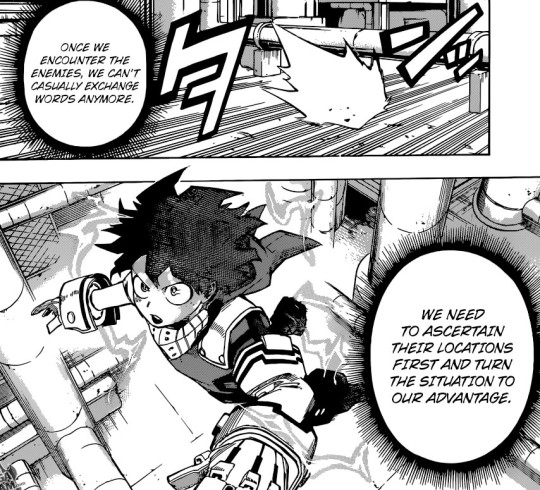
oh shit hold up

...so it occurs to me again that that’s exactly what triggered his first One for All: Avatar State experience to begin with though, way back when. Shinsou brainwashed him and then the Ghosts of One for Alls Past appeared for the first time and activated OFA without him being aware of it -- very much like what happened the night right before this training exercise
and now here he is fresh from that weird dream and possibly about to be brainwashed for a second time. is this really a coincidence? seeing as I’m reading a fucking manga, I’m gonna go ahead and say hell no
shit now I’m even more excited
so Iida is observing that Team Deku’s formation looks similar to Team Bakugou’s, and Sero says that’s not a surprise since they’re similarly balanced. true that
but he’s pointing out that they don’t have a Jirou -- someone who can pinpoint the enemy’s location -- so they need to be more careful
yeah, especially since unlike Team Kacchan, they’re up against Shinsou who can take out their most powerful player in a second if he hits them unawares
anyways don’t mind me I’m just gonna post this part here
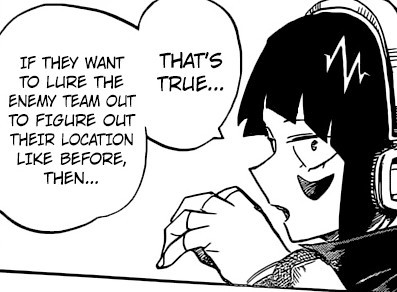
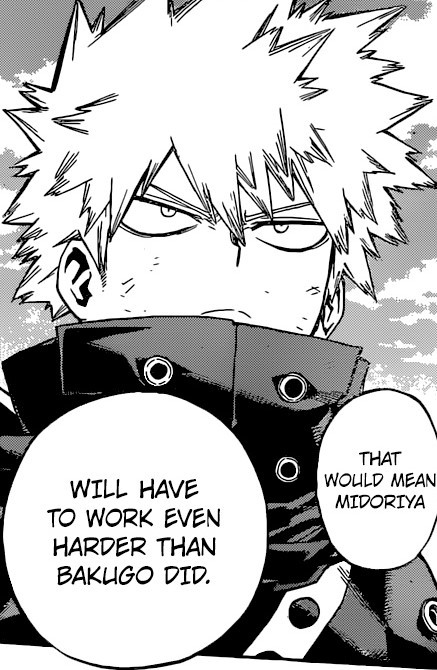
so Bakugou watching Deku without that characteristic over-the-top seething rage is still such a novel thing, though. him feeling threatened by Deku’s growth was really the key thing holding that relationship back. now that that’s no longer an issue, he’s observing this match with a surprisingly keen intensity
and what I love about this is that it’s exactly what he said he was gonna do back in chapter 121. he vowed that he would observe and absorb what he sees from others in the same way that Deku does in order to become stronger. he’s watching this match so intently because he wants to learn from Deku. do I even need to say how big of a deal that is and how far he’s come? just, wow
so Deku’s coming to a halt on one of the pipes and he’s silently pointing to something
okay so he’s putting his plan of “I’ll be a decoy” into action
seems like this is his way of compensating for his team not having a Jirou. if they can’t pinpoint class B’s location, they’ll just draw them out instead
now an oil drum is tumbling out from somewhere and it seems like it’s caught his attention
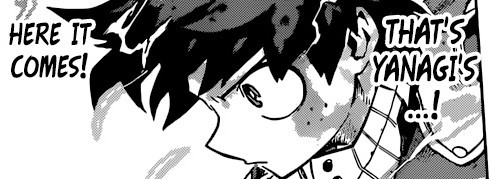
who’s Yanagi. lol I guess we’re about to see, what with the HERE IT COMES
OH SHIT

DEKU IF YOU THINK FOR A SECOND THAT’S HER... COME ON MAN, YOU’RE SMARTER THAN THIS
so he’s turning around and Monoma is there

don’t you dare fucking respond you little green bean. just kick him in the head and knock his ass out. this is a training exercise, you know Ochako’s not at any actual risk. and she can handle herself. these guys are gonna be banking on your heroic instincts in the same way the previous team was counting on Kacchan to be the same self-centered asshole he always was before. you guys are so fucking strong the only way they can beat you is by exploiting your mental weaknesses
oh snap Monoma’s holding up his pocketwatches. way back when his costume was first revealed I speculated that he might use them to time his quirk, so I guess we’ll see if that’s the case? I suppose they could also be support items and have some unexpected tricks to them
anyway he’s talking a lot, as usual
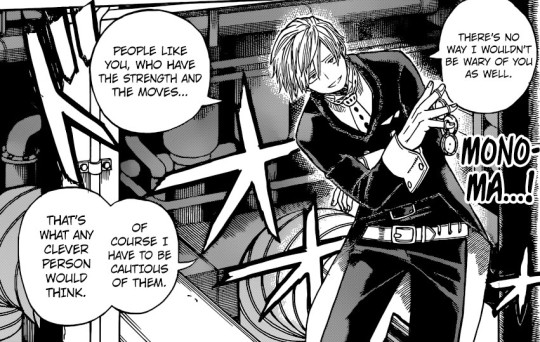

a clever person would also think “I’d better not respond to his baiting here since that’s obviously what he wants”
having said that, Monoma’s not wrong. that would be a good strategy for them to actually have. but I don’t think it’s their real strategy lol
ahh, good, Deku is being clever and cautious and knows better than to respond to him

lol so Deku just go KO him already! why are you keeping your distance?? you once said back at Kamino that you could make it from where you were standing to where Kacchan was in under a second with one leap using OFA. that’s fucking fast. you’re faster than the kid who basically fucking teleported in between Kamakiri and Jirou a couple chapters ago. just zoom over to Monoma and kick him in the head. come on. do it
jesus christ Monoma knows what his strengths are doesn’t he
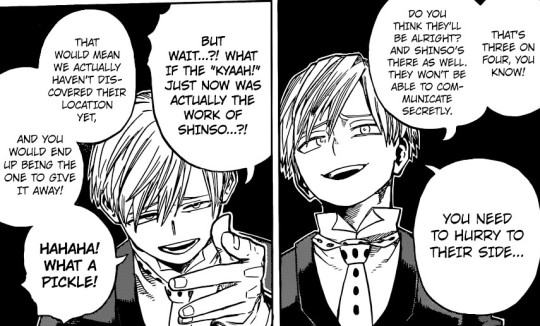
he knows how to fuck with his opponent, I’ll give him that
so now Deku is finally leaping toward him like I said! about time

not sure if that’s actually the case, but he’s probably not too far off the mark, and I think he’s making the best possible move here given what he knows
uh oh

what is he doing
OH FUCK ME
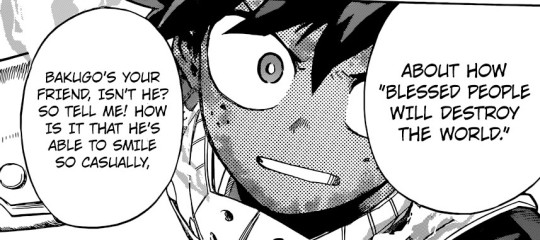
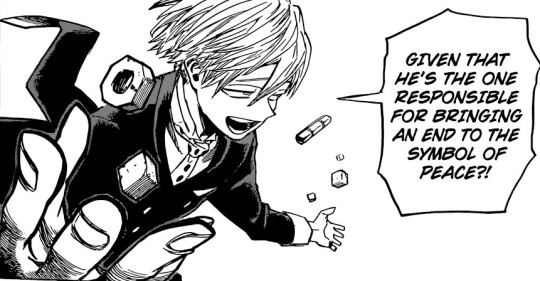
OH FUCK NO MONOMA. YOU DID NOT JUST
WHAT THE HELL DUDE. IS YOUR SPECIALTY BELOW-THE-BELT ATTACKS OR WHAT?? COME ON OVER AND SAY THAT TO BAKUGOU’S FUCKING FACE WHY DON’T YOU. JESUS CHRIST THAT WAS LOW AS FUCK
and obviously he’s just trying to provoke Deku into responding still! but man, what a way to do it! you’ll resort to anything, huh??
do they have sound on those viewscreens, or just visual? I feel like it’s both, though I’m not gonna stop and go back and check right this second. anyways I’m just wondering if Kacchan heard that, since we know all too well he does feel personally responsible, and now here’s Monoma trying to poke at this recently-healed wound and reopen it again. and Dad Might is probably still on the phone with Gran. damn it Monoma you better not have sent him spiraling again. I will send you the therapy bills
(ETA: so yeah, they absolutely do have audio, it was confirmed in chapter 197. so Kacchan did indeed get to hear that, and everyone else heard it too, and it was probably super awkward, and probably would have been even more so had Deku’s arm not fucking exploded with his goth red vines quirk mere seconds later causing everyone to pretty much forget about anything else.
and by the way, can we just quickly touch on the fact that Hellboy later explains to Deku that “if you wield your power in anger, the power will respond accordingly”? in other words, Monoma pissed him off so much here that he went and activated a quirk he didn’t even know he had and it proceeded to go on a roaring rampage of revenge. so what have we learned today, kids? don’t insult the boyfriend, is what.)
anyway the good thing is Deku’s aiming his air gun at him and still isn’t responding, although he does look fucking furious and no wonder
now we’re cutting back to Team Float/Melt/Stick
and we’re confirming that the “kyaah” was indeed Shinsou which of course it fucking was. Ochako doesn’t KYAA, she ain’t no fucking damsel in distress
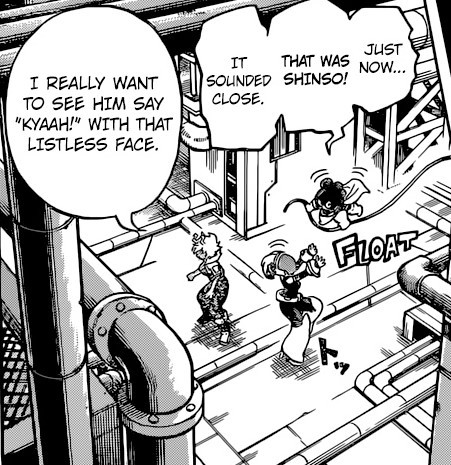
lol now I want to see it too
so Ochako’s reminding the others to look at each other’s faces when they talk
what have you been up to Mineta
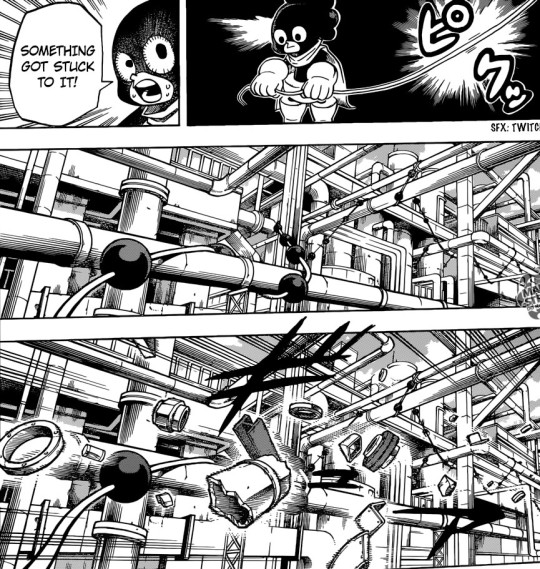
holy shit a whole fucking lot got stuck to it. what the hell is this anyway
Mina’s protecting them all with a veil of acid, which is fucking badass. Mina I love you
and now we’re cutting to Shouda for a second and he’s watching them and says “they vanished”...?
ah!!!
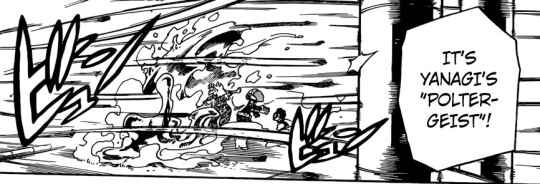
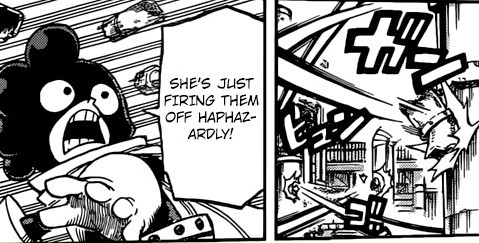
IS THIS A TELEKINESIS QUIRK!? AT LONG LAST???
HOLY SHIT
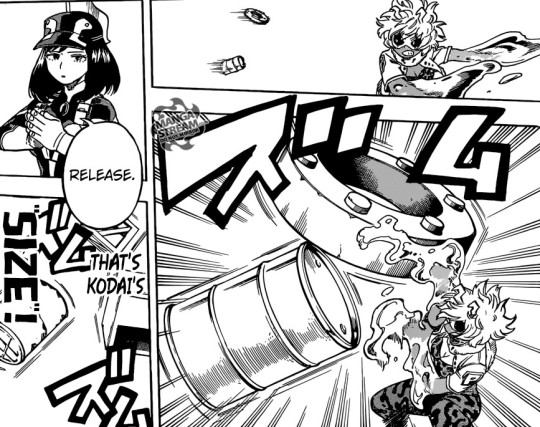
THAT’S LIKE FUCKING COMPRESS’S QUIRK. WE’RE GOING FULL ANT-MAN UP IN THIS BITCH. HOLY SHIT CLASS B, IT’S JUST BADASS QUIRKS ALL THE WAY DOWN WITH YOU GUYS HUH
holy shit. I love both of these, but the size quirk especially. that’s so fucking good. I wish she was in class A now, ngl. so many potential applications of this
and how many quirks can Monoma handle at once? he had three pocket watches so I’m gonna go with three. so I’m assuming he took both of theirs along with Shinsou’s, since he was also floating small objects earlier
Ochako’s a good person to have against a quirk like this, though!
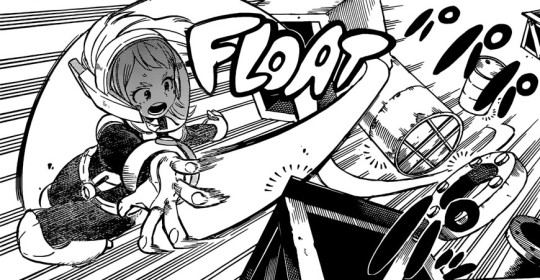
and now just smack them away again! take that
NOW WHAT
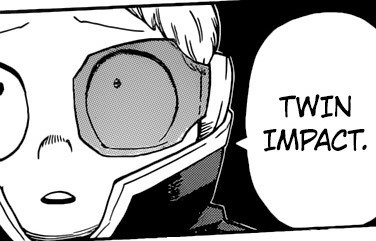
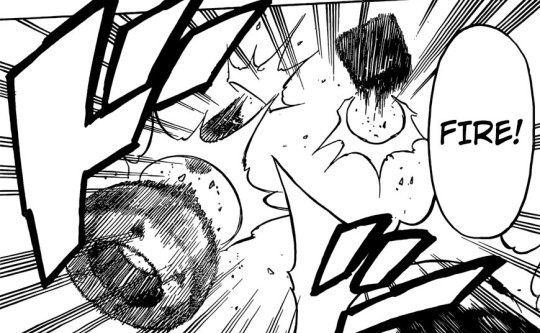
what the hell
sob omg
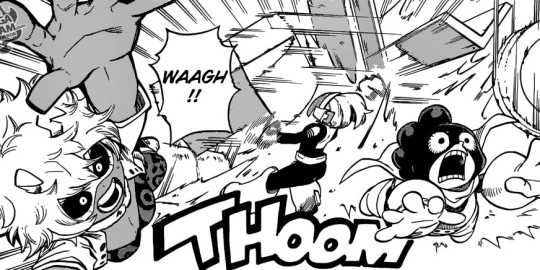
I would just like to point out that this was a WAAGH and not a KYAA though. for the record. even when they’re being attacked by rampaging thooming metal objects, class A does not KYAA. we die like men
so here are the deets!
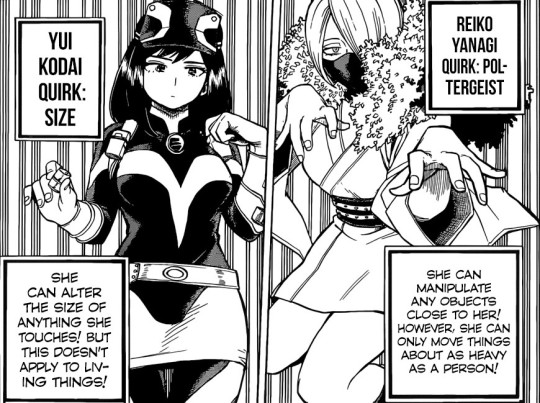
telekinesis quirk confirmed yessssss. this is like a way upgraded version of Inko’s quirk. so glad we finally get to see a hero do this shit too
Kodai’s quirk is so badass and I love it. though it’s too bad she can’t shrink people too. lots of hijinks potential there. ah well
and Shouda’s quirk too!
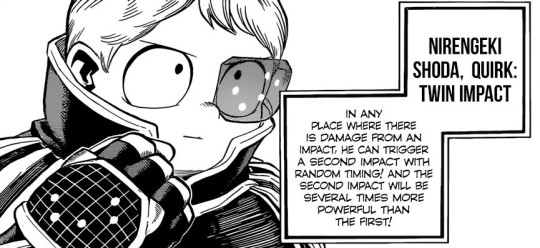
ngl, I read this and I was like ‘what.’ I had to reread it several times and then go look him up in the wiki just to make sure I got it. this is one of those cases where a “for example” would have really come in handy. but anyways I think what this means is if someone hit a baseball, then he could recreate that impact in the same spot a second time, and not only that but the second impact would be stronger by several orders of magnitude. idk it’s weird and confusing
(ETA: seeing it in action later helped me understand the concept better, but I still for the life of me can’t explain it in words lol. super cool quirk though.)
anyway so even though all this crazy stuff is going on, neither team has actually come face to face with the other yet and they’re all still attacking each other from a distance, except for Deku and Monoma. so now Ochako’s wondering what happened to Deku
and now back to All Might! damn, Horikoshi, you sure know how to cut away from something just when it was getting good
so Gran says it’s probably not what All Might was looking for, but right around when Shimura first inherited One for All, he and her had a casual conversation whilst on patrol
NO, DEKU!!

WHY DID YOU OPEN YOUR MOUTH DAMMIT
WHAT’S GOING ON OH MY GOD. ALL OF A SUDDEN ALL OF MY FAVES LOOK SHOCKED
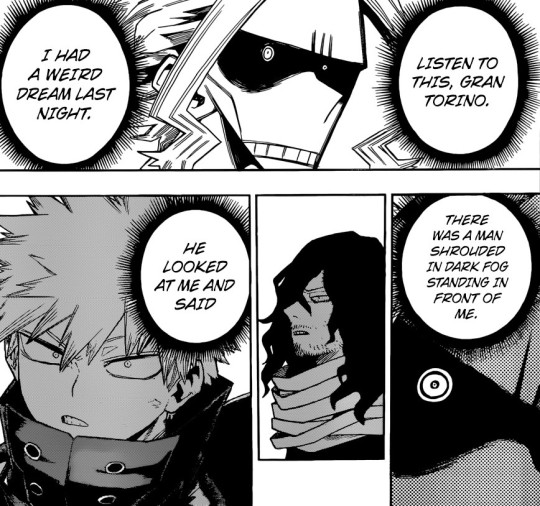
oh I know this. “plaaaaay the best song in the world. or I’ll eat your souls.” so we played the first thing that came to our heads and it just so happened to be the best song in the world. it was the best song in the world
lol okay so let’s see why they all seem so shocked. IS IT THE SPOILER!?!?
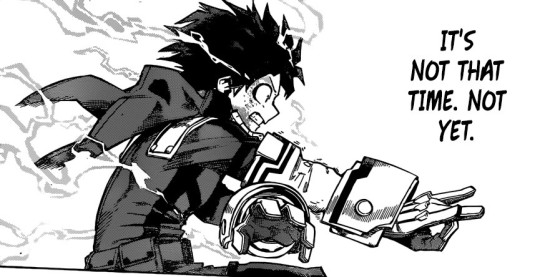
IT’S NOT? OKAY? WHO ARE YOU??
(ETA: this is just the continuation of Gran’s story from the previous page, doy.)
WHAT THE FUCK
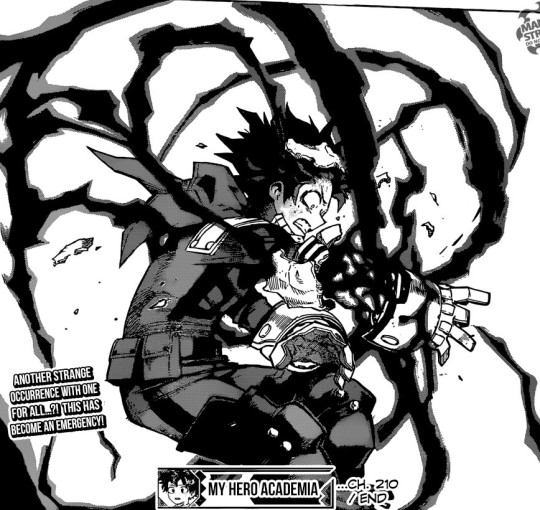
okay then! lol. well that explains the “wtf” expressions
so what exactly was Deku about to do that OFA took over and was like DEKU NO. were you going to fucking kill Monoma over insulting your boyfriend. is there some reason OFA lost its fucking shit and activated one of his secondary quirks for the very first (or second, I guess) time, right here and right now? or is the “it’s not that time” what the old man said in Shimura’s dream, and now with Deku it finally is that time?
oh my god. even knowing a little about what’s going on, I still really have no clue and I fucking love it. this is insanely cool and tbh the Joint Training arc is like #4 on my list now and will possibly be #3 by the time all is said and done. IMO this twist is cool and unexpected and will make future battles much less boring (because let’s be honest, Deku’s last couple of fights were really not all that dynamic. this is definitely going to help vary things up a bit), and I can’t wait to see how All Might and Kacchan react too omg
just. thumbs up from me
#bnha#boku no hero academia#midoriya izuku#monoma neito#uraraka ochako#ashido mina#yanagi reiko#kodai yui#shouda nirengeki#bakugou katsuki#gran torino#all might#bnha spoilers#mha spoilers#makeste reads bnha#gonna need to do a thorough scan of the shinsou tag on tumblr#gotta see if someone has done fanart of shinsou saying 'kyaah'#mina is absolutely right to fixate on that#between observations like this#and her shipping every two characters who stand next to each other#I feel like the two of us are kindred souls#or at least we would be if I was even half as cool as her#anyways
82 notes
·
View notes
Text
Novel Review: Automatic Reload by Ferrett Steinmetz
Hei Hei and Welcome to MacroMicroCosm Literary Review…
Novel: Automatic Reload Author: Ferrett Steinmetz Publisher: TOR Books (2020) Rating: 4/5 Stars
Today we are diving cautious as a paranoid quadruple amputee cyborg into the cyberpunk romantic kill zone known as Ferrett Steinmetz’s Automatic Reload published in 2020 by Tor Books. Strap into something, prepare your payloads and it’s time to dive in.
I borrowed Automatic Reload’s audiobook from my municipal library’s Libby app, and will be critiquing the audiobook narration by Tim Campbell via Macmillan Audio with Steinmetz’ prose. Tim Campbell’s narration hit my auditory nerves with the same grit as a Private Eye in my spouse’s beloved old radio shows. Instantaneously, I was brought back to The Shadow, and Red Panda Adventures. Mat’s internal narration was made vivid with Campbell’s grit. All goes as expected for a guttural masculine-led audiobook… until Campbell narrates female characters. The grit and gruff voice of our narrator and protagonist Mat (whose name I missed completely for the first few hours of audio storytelling), shifted to a nasal ‘quasi-feminine whine’ each a tad different for the few feminine characters in the novel. While off-putting to hear limp feminine audio, it didn’t stop me from listening to the entire audiobook. I wish Macmillan Audio hired two voice actors, that Sylvia and Trish especially were voiced by a woman. I don’t envy Campbell’s options with Sylvia’s voice, especially in the beginning, Sylvia is a panic-attacked whimpering victim and Mat the rough but conscience-bound redeemer. Maybe it’s a pet peeve of mine, when listening to audiobook narration with too ‘breathy’ a character voice, or too much differentiation between a narrator’s timbre and the various dialogue, but it threw me out of Automatic Reload’s prose a few times and elicited many a rant among our MacroMicroCosm discord server on the nature of respecting female characters by allowing them a more natural voice, and not a whining nasal whimper. It’s unfortunate, because Tim Campbell had the perfect voice for Mat’s rough narration. All in, this was the only issue with the audiobook version of Automatic Reload.
On to Steinmetz’s prose. While entertaining, and a fun way of portraying neuro-divergent characters, Automatic Reload is not making it into my top cyberpunk novels. As it was billed to be a cyberpunk romance, the choice to spend a vast third if not half of the novel in a first-person narrator-protagonist dry technological readout of the various guns, cybernetically augmented prostheses and associated weapons-come-defence programs felt stale as a slice of bread on the kitchen counter in summertime. Maybe engineering isn’t my thing, I know of several friends who would love such attention given to the weaponry, and recommended Automatic Reload to all of them, but a good hour into the prose and all I knew of Mat was the amount of weaponry he possessed on his specialized limbs, that he was attempting to halt a kidnapping, and he was paralyzed with the incapacity to kill. A decent bedrock for a PTSD scarred main character, Mat’s inability to take life becomes a mainstay of the manuscript. This is not in itself a negative. It makes for intriguing prose, and shows his caring, ethical side.
But I could not help feeling Mat’s selfish delusions within the first few chapters. His first-person narration of saving the teenaged girl became more about saving the people, who caused her fear and harm at her expense. When I taught self defence in a university and martial art academy setting, one of the first lessons (especially to the female students) was a defender has the right to go home. The attacker has every opportunity to stop harming you, and them refusing to let go is them allowing you to defend your right to survive unharmed as possible. In the introductory arc, Mat rescues a girl from kidnappers, who are prepared to kill her. Regardless of how noble Mat was in his attempts of causing less harm, I could not stop thinking of the harm he was causing to the poor girl frightened out of her mind, with a knife against her neck. Steinmetz goes so far as to have the girl bleed from a superficial slice to the throat, before our ‘wounded hero’ intervenes in a kinetic fashion.
Mat is not a hero, his paranoia at preventing harm does not make him precisely good. It does, however, make him a fascinating study of an injured veteran compensating for the horrors of war. He reminds me of Perseus, played by Sam Worthington in the 2010 released Clash of the Titans, where Perseus discovers his demi-godhood and struggles to go about his mission as a normal man, not a god. As if his spectacular powers were to be feared or forgotten in self-hatred rather than used to others’ advantages. Even when companions on his voyage begin to die, Perseus sticks to his selfish morals and refuses his inner power until it is all but too late. Just as Perseus could have saved multiple companion’s lives had he accepted his power, so too Mat could have saved the girl from trauma (injection of ‘anti PTSD drugs’ notwithstanding) if he hadn’t attempted to wait the kidnappers out as long as he did, until a last second where she looks into his faceplate and knows she is about to die.
As protagonists go, Mat is an insecure, selfish moralist with his own set of obsessive edits, who passes it off as a sheriff’s bravado in the wild world of body hacking. When his contact and seemingly only friend Trish (whom I loved) gets him a job worth millions, Mat dives in to prevent collateral damage only after she cajoles his ethics, and that is noble. But this is where the novel takes its’ turn. I won’t be going into spoilers much here, but from the moment Mat meets assassin-damsel in distress Sylvia, I could see where the novel’s plot was going, and for the most part I was 9 for 10.
Sylvia’s panic and anxiety disorder took centre stage, as Mat tumbled with her assassin-programmed artificial body, and the other body-hackers who were looking to bring her back and finish their job. The bonding between the two (through ‘old timey cinema) was ultimately endearing but fairly stock, between the constant verbal output of every single technological gadget Mat had on hand, or modified to work, or picked to replace old limbs, or because we were at another moment, where Mat needed to drone on about the tech as if to remind us that we were, in fact, in a cyberpunk setting.
My major criticism of the prose isn’t Mat’s struggle with harm reduction, but the sheer amount of technological data Steinmetz pushed into the manuscript, until I felt like half the novel was a sci-fi reader’s guide to emotionless guns, cybernetic components and threat awareness programming. At a fairly early point in the prose, the tech talk got so redundant if I hadn’t been listening on audiobook in my car, I’d skip pages. Yes, I can see this was a coping mechanism for Mat, and the best way Steinmetz had to frame the science fiction setting in a novel completely from the protagonist’s inner monologue (a literal ’subvocal recording’ as we discover), but it threw me. Automatic Reload lacked a balance between the cold cover of Mat’s obsessions and the emotionally gorgeous story of two wounded people falling in love… while being chased by psycho body-hacking killers.
It’s unfortunate, because the relationship development between Mat and Sylvia is agonizingly sweet. Their ability to both freak out and help each other, the peppering of laughter to break the tension of their run with death were all wonderfully done. Trish, Mat’s business contact and friend is the stand alone best character of the novel. Sassy, strong and incapable of selfish intentions, Trish gives Automatic Reload the backbone it needs to evolve both Mat and Sylvia and drive the plot forward, even through the constant re-hashing of the setting as Mat experienced it. I cared about Trish more than I cared about Mat or Sylvia, beyond their growing connection. The enemies, while trope-ish, were believable in their immensity, and brought me to the feel of a 1980’s action flick with Van Damme, or Norris at the fore… if their female lead happened to be more powerful than the Hulk in Thor: Ragnarok.
Steinmetz’s plot in Automatic Reload is visible miles before the chapter headings, and that is unproblematic, if you’re looking for an easy, entertaining read similar to that 1980’s action flick. I won’t say the climax didn’t take a twist, it did, but even when the twist occurred, I again called what would remain of the plot. If you want a cyberpunk weapon’s heavy cute-couple novel to relax with, this will certainly do it for you. Aside from its’ flaws, Automatic Reload has a vulnerability and joy to its escapism, the clinging growth of a relationship in two freaked out, lonely people.
Mat does grow through his moments with Sylvia, but especially with Trish’s advice. If you like to know the technological readout of every warrior’s equipment, watched the Matrix and Maltese Falcon, and enjoy a good gritty radio-show, with romantic plot-line, Automatic Reload is for you. I give it four out of five stars, and imagine the ideal reader would be of the masculine or tech-minded variety who is woke enough to handle a gritty romance with more bullets than people, a transgender best friend, and heroes whose anxiety and PTSD cause as many problems as they eventually, and inevitably, solve.
For those who want something to listen to of a similar feel, I thoroughly advise listening to the Red Panda Adventures.
0 notes